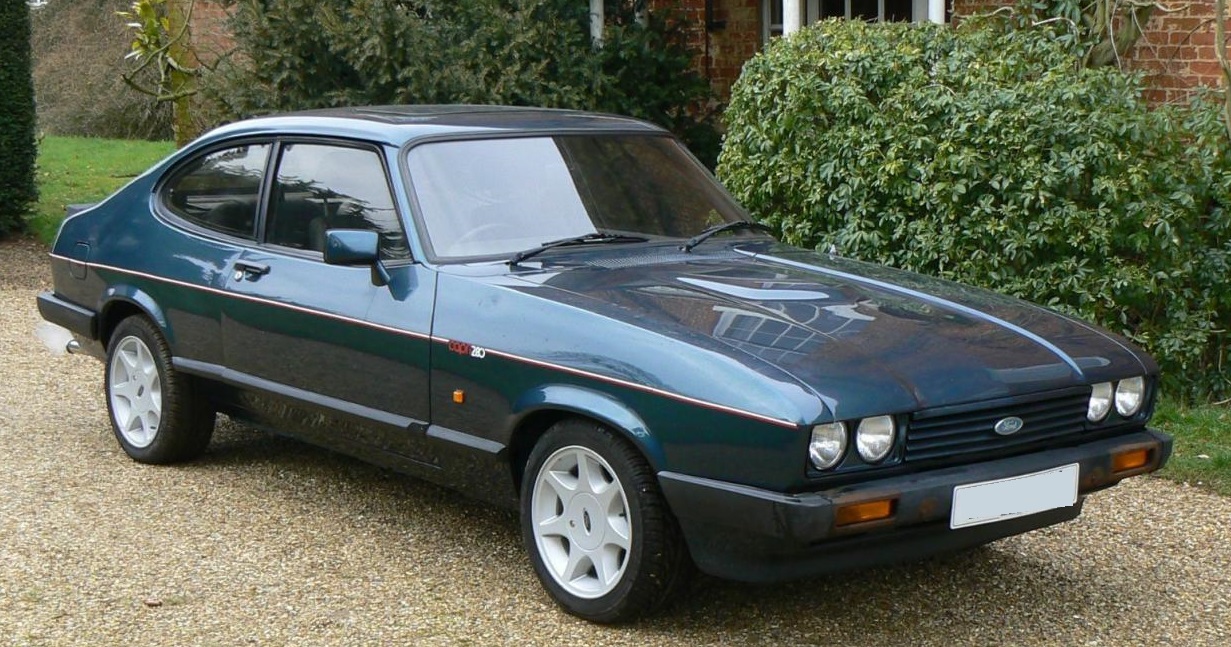-
Insurance
InsuranceAbout our productsLearn about insuringGet a quote Get current values, historical values, model history and more.
-
Valuation
ValuationHagerty valuation toolLook up a vehicle value Get current values, historical values, model history and more.
-
Events
EventsHagerty official eventsHagerty ClubhouseEvent calendar
-
Entertainment
EntertainmentMore to explore
- Portal login
1985 Ford Capri
III 2.0 Coupe 2 L
Vehicle values by condition
Fair
Condition 4
£4,900
#4 cars are daily drivers, with flaws visible to the naked eye. The chrome might have pitting or scratches, the windshield might be chipped.
Good
Condition 3
£8,100
#3 cars could possess some, but not all of the issues of a #4 car, but they will be balanced by other factors such as a fresh paint job or a new, correct interior.
Excellent
Condition 2
£12,700
#2 cars could win a local or regional show. They can be former #1 cars that have been driven or have aged. Seasoned observers will have to look closely for flaws.
Concours
Condition 1
£19,800
#1 vehicles are the best in the world. The visual image is of the best car, unmodified, in the right colours, driving onto the lawn at the finest concours.
Insurance premium for a
1985 Ford Capri III 2.0 Coupe 1993
valued at £8,100
£181.10
/ year*
History of the 1978 - 1986 Ford Capri

1978 - 1986 Ford Capri
The Ford Capri was designed by Philip Clark as a European equivalent to his earlier Mustang. It was launched in 1969 at the Brussels Motor Show and remained in production until 1986. The Capri is a four seat, 2- door GT and came to represent affordable sporting style for a generation. It is front-engined with rear-wheel drive.
The Ford Capri Mark 1 was produced from 1969 to 1974. It was offered with a large range of engines and trims from the start, these varying from market to market. This was a strategy that would remain throughout the production for all marks of Capri. The floor pan and suspension are shared with the Cortina, incorporating a live rear axle and MacPherson Strut front suspension. The Mark 1 Capri had a facelift in 1972 which included new lights and a softening of the suspension.
In 1974 the Ford Capri Mark 2 was introduced, continuing in production until 1978. This was a less fussy design than the Mark 1 with altered proportions decreasing the length of the bonnet whilst allowing for a longer cabin. This along with the change from a booted body shell to hatchback increased the practicality of the car. The JPS limited edition Capri with black paint and gold pinstripes was produced in 1975.
The Mark 3 was brought in during 1978 and ceased production in 1986. This was a more subtle change, with the Mark 3 looking similar to the Mark 2. The aerodynamics were improved though and this resulted in an increase in performance. The 2.8i joined the range in 1981 with a fuel injected version of Ford’s V6 engine. During the Ford Capri Mark 3’s life semi-official low volume versions were also produced by Tickford and Turbo Technics. The final version was the run out 280 which was fitted with a limited slip differential.
In the UK the 1300, 1600 and 2-litre engines were available from the start and remained a constant during the complete life of the car. There are complications caused by the engines used being of both Kent and Essex varieties. The 3 litre V-6 was added to the range in 1969 and a limited run was also produced with a 3.1-litre version of the engine. The final change to the engine line up occurred in 1981 when the 2.8 injected V-6 was included in the line-up. The Ford Capri was introduced with only a 4 speed manual gearbox, the 3 -speed automatic gearbox arriving with the Mark 2. A 5-speed gearbox was fitted for the run-out model only.
The Ford Capri was tarnished by the image of being a “boy racer’s” car from the outset but time has brought both respectability and desirability. The roomy four-seat cabin makes this a practical car, especial in Mark 2 and Mark 3 guise. The Cortina underpinnings cannot be disguised and the Ford Capri tends to naturally wallow into understeer but the light rear means tail happy oversteer is never too far away. This is not helped by an imprecisely located back axle adding a degree of uncertainty but readily available performance parts can transform the handling.
The usual unsophisticated yet effective Ford mechanicals used throughout the range at the time mean that this is a simple car to work on. The mechanical parts are also readily available but panels and trim can be expensive. The Capri particularly rusts around the front valance and headlight surrounds as well as the wheel arches. The drains in the spare wheel well need to be kept clear. Because of their size and weight the doors are also prone to dropping on their hinges.
Large engines and rare trims are generally sought after when purchasing Ford Capris. Each Mark has its own adherents although traditionally the Mark 1 has usually been seen as the most desirable.
Alternatives to the Ford Capri can be found in the BMW 2800 CS, the Sunbeam Rapier fastback and the Fiat 130 coupe.
All 1985 Ford Capri body types
| Year | Make | Model | Submodel | Body Type | Engine size | Average value |
|---|---|---|---|---|---|---|
| 1981 | Ford | Capri | III 2.8i | Coupe | 2.8 L | £ 8,700 12,600 20,800 28,900 |
| 1978 | Ford | Capri | III 2.0 | Coupe | 2 L | £ 4,900 8,100 12,700 19,800 |
Hagerty Newsletter
Get your weekly dose of car news from Hagerty UK in your inbox

ADVERTISEMENT